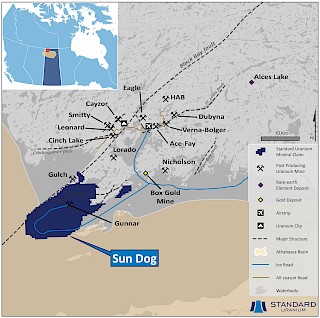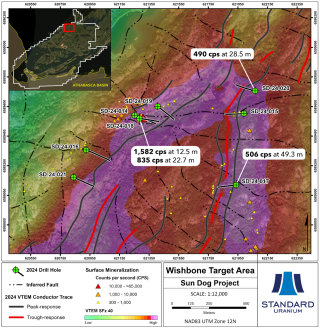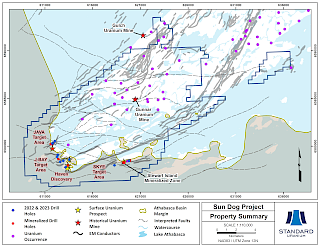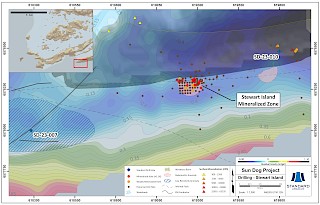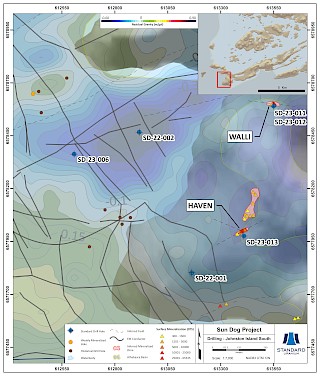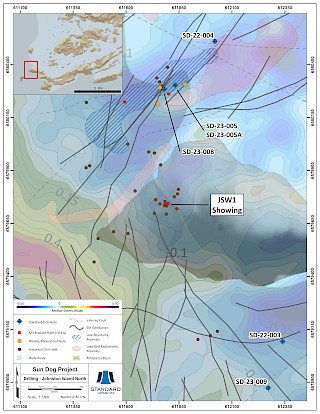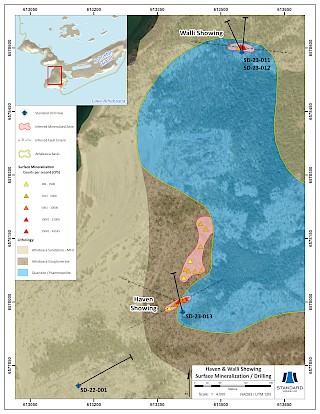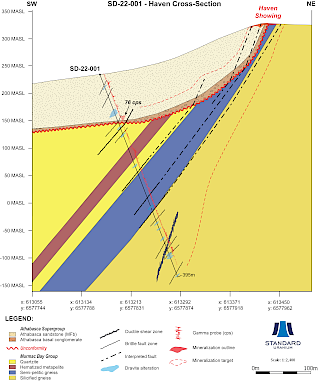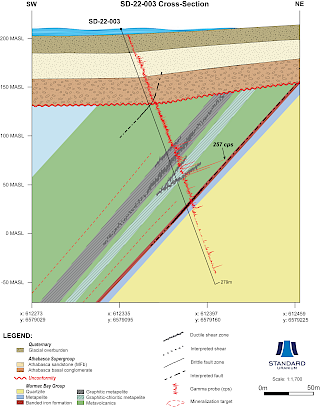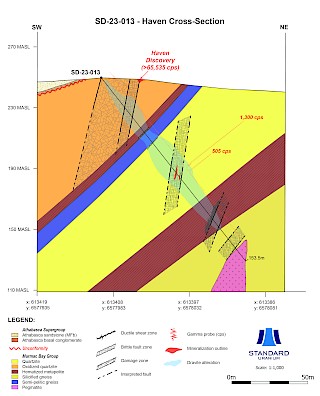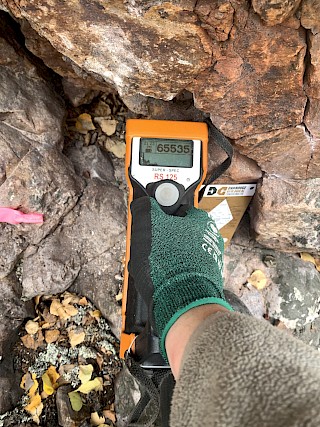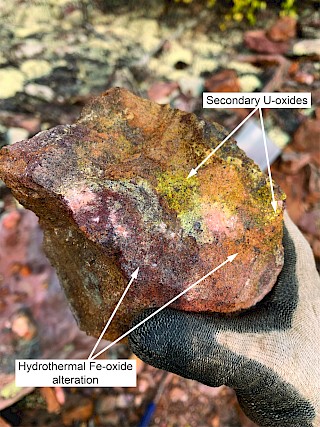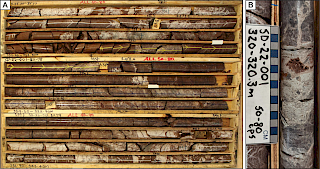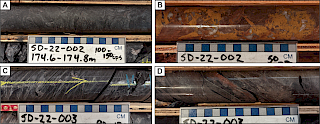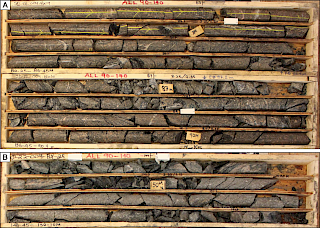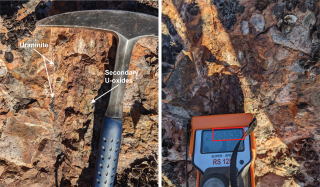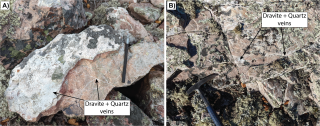Sun Dog Project
Project Overview
Standard Uranium holds a 100%-interest in the 19,604-hectare Sun Dog project along the northwestern edge of the Athabasca Basin. The Sun Dog project is comprised of 9 mineral claims located near Uranium City and contains the historic Gunnar uranium mine in the prolific Beaverlodge district where uranium was mined between 1953 and 1982. Unlike the previously mined lower-grade Beaverlodge type deposits from this area, Standard’s exploration strategy at Sun Dog is targeting high-grade unconformity-related deposits that are typical of the Athabasca Basin, which would be a remarkable discovery in Canada’s original uranium mining district.
Three of the most promising historical target areas (Skye, Java, and Stewart Island) were visited in Fall 2020 to confirm the location of historical exploration results and provide context for current work. Prospecting lead to the discovery of a new high-grade surface uranium showing, named the Haven discovery. Fall 2020 sampling efforts at the Skye, Java, and Haven target areas identified several zones of off-scale and visible uranium mineralization at surface, and returned uranium assay results up to 3.58% U3O8, 1.7% U3O8, and 0.7% U3O8, respectively. Additionally, the analytical results reveal a correlation between uranium and gold mineralization, while boron and other pathfinder elements highlight the potential for a robust alteration footprint associated with uranium mineralization.
The Company has completed three reconnaissance-scale drill programs on the project totalling 4,062 metres of diamond drilling. Highlighted by the first drill hole at the Haven discovery, SD-23-013, which intersected 1.5 m of elevated radioactivity up to 1,300 cps including 0.5m of uranium mineralization up to 0.042 wt.% U3O8 associated with a strong alteration halo. The summer 2024 drill program comprised eight drill holes totalling 1,593 metres at the high-priority Wishbone target area following completion of a VTEM Plus survey and geophysical modeling.
Highlights from the project include:
Skye Target Area
- Uranium mineralization was confirmed near the Stewart Island deposit at the Skye target, which is composed of three main uranium zones – The main, east, and west zones.
- 14 outcrop and boulder grab samples collected, 6 of which returned greater than 0.10% U3O8, and range between 0.95 ppm U and 3.58% U3O8.
- 3 of the 14 samples returned greater than 100 ppb gold with a high of 1.02 g/t Au.
- The confluence of EM conductors, resistivity-low, and interpreted faults remains the un-tested potential at the Skye Target area. The Company continues with the exploration model that the Stewart Island deposit mineralization could potentially be related to an unconformity-related uranium deposit located less than 1 km to the west.
Haven Discovery
- Three prospects visited in 2020, and 13 samples collected at the Haven discovery, including a previously undocumented prospect found by the Standard team.
- Of the 13 outcrop samples collected, 5 returned greater than 0.10% U3O8, and range between 136 ppm U and 0.70% U3O8.
- 3 of the 13 samples returned greater than 100 ppb of gold, with a high of 1.04 g/t Au.
- Located at the historical Walli Prospect, 2 of the 13 samples returned greater than 1,000 ppm boron. These results, coupled with the anomalous uranium of 0.10 and 0.13% U3O8 and elevated pathfinder elements such as lead, arsenic, copper, cobalt, and nickel suggest the identification of a robust alteration footprint within the Athabasca sandstones.
- Drill hole SD-22-001; 325 m step out from known surface mineralization at Haven
- Intersection of several hydrothermal quartz-hematite breccia structures ranging from 1.0 to >10.0 m in drill hole thickness – Strong hydrothermal fluid flow
- Intersection of dravite-illite-quartz hydraulic breccia from 320.0 to 320.3 m
- Drill hole SD-23-013; Haven discovery:
- Down-dip follow up of fault-controlled off-scale (65,535 cps) surface mineralization at the Haven discovery
- Significant structure and oxidation front alteration (hematite-limonite) from the top of hole to 33.5 m
- Elevated radioactivity from 79.0 to 80.0 m up to 1,300 cps (1,000 cps on handheld RS-125), and from 83.0 to 83.5 m up to 505 cps (320 cps on handheld RS-125), associated with a 10.25 m wide oxidized fault breccia and clay-dravite alteration
- Several additional intervals of quartz-hematite breccias
Johnston-Bay (J-Bay) Target Area
- Drill hole SD-22-002; 543 m step out SW along strike from known mineralization
- Intersection of highly deformed graphitic metapelite, quartz-hematite and limonite hydrothermal breccias
- Drill hole SD-22-003; 450 m step out NE along strike from known mineralization
- Intersection of deformed graphitic metapelite lenses overprinted by hydrothermal quartz-hematite breccias
- Elevated radioactivity from 164.5 to 167.0 m, up to 300 cps, associated with graphite-hematite fractures in metapelite
- Drill hole SD-23-006; 343 m step out southeast of mineralized drill hole LAI-05, targeting the confluence of several conductors within a gravity low gradient
- Possible dravitic-clay intersected within Athabasca sandstone at 63 m
- Numerous metre-scale brittle-reactivated shear zones with moderate to strong graphite
Java Target Area
- 14 outcrop grab samples collected in 2020, 10 of which returned greater than 0.10% U3O8, and range between 0.07 ppm U and 1.7% U3O8.
- 8 of the 14 samples returned greater than 100 ppb gold with a high of 0.52 g/t Au.
- The convergence of EM conductors, underwater radiometric readings, resistivity-low and interpreted faults, associated with historically identified uranium in the strongly altered and brecciated, chlorite-, sulphide-, and graphite-bearing metasediments in the basement rocks below Athabasca Supergroup sandstones remains the primary target for follow-up exploration by the Company.
- Drill hole SD-22-004; 330 m step out NW along strike from known mineralization
- Altered orthogneiss units with metre-scale brittle structures
Wishbone Target Area
- Approximately five kilometres of strike length along a regional scale anticline, defined by strong VTEM conductors with associated radioactivity that has never been drill tested.
- Graphitic pelitic rocks have been mapped along both fold limbs, hosting strong radioactivity up to 22,300 cps.
- Mineralized cross-cutting faults have been mapped in the overlying rocks which intersect the uranium-bearing graphitic pelite unit.
- Historical outcrop sampling at the northwestern graphitic pelite exposure returned assay results of 0.32% U3O8 and 0.30% Cu (SMDI #2095).
McNie Target Area:
- Approximately four kilometres of untested VTEM conductor strike length.
- The corridors are off-set by significant E-W trending regional faults, which host known uranium showings to the east towards the newly discovered zone at target H15 on the Murmac Project, and to the west towards the past-producing Gulch uranium mine.
Spring-Dome Target Area:
- Historically explored Gunnar-style target focused on mineralized carbonatized granites and pitchblende veins and fractures.
- The Spring-Dome area has been historically drilled with intersections over 1.0% U3O8; however, several showings of uranium south of known drilling with values up to 17.4% U3O8 and radioactivity readings >65,535 cps have not been properly drill-tested.
- The Company is currently evaluating the priority of this area through prospecting, mapping, and geological modeling. The target area south of Spring Lake represents the possibility of a uranium deposit akin to the nearby past-producing “Beaverlodge-style” Gunnar mine.
The target areas at the Sun Dog project have many attributes that are favourable for the formation of high-grade unconformity-related uranium mineralization. The key geological factors include uranium-enriched bedrock, reactivated and graphitized structures, Athabasca Supergroup sandstone cover, and favourable basement competency contrasts.
Maps & Figures
Disclosure of Technical and Scientific Information
Except as otherwise noted herein, Sean Hillacre, MSc. P.Geo., Standard Uranium’s VP Exploration, has reviewed and approved the scientific and technical information contained in this website. Mr. Hillacre is a Qualified Person within the meaning of Canadian Securities Administrator’s National Instrument 43-101.

